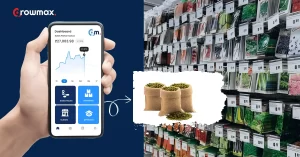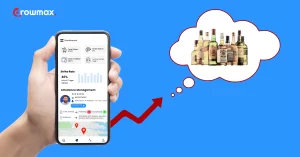An average salesperson spends less than 36% of his time actually selling. More than 64% of the time is drained on unproductive tasks that do not generate revenue.
He spends most of his time steering across the map, scribbling the sales orders, and dumping data into spreadsheets. Repetitive tasks devour his free time and distract him from performing his actual job, which is selling.
This article will focus on the solution: Sales Force Automation. We will see how it transforms field sales and discuss its definition, mechanics, and benefits.
What is Sales Force Automation?
The daily schedules of field teams are full of manual tasks — tasks that reduce their efficiency and hinder their workflow — like coordinating, beat planning, and sales information management.
Technology can automate around 30% of a company’s sales tasks, including almost all the manual ones discussed above, freeing teams to cover more outlets and increase sales.
Sales Force Automation (SFA) is a solution that automates these bottlenecks for the field teams to focus more on selling than doing mindless tasks. It frees their minds and schedules them to concentrate on revenue-generating tasks.
Processes that SFA Automates
SFA solutions automate almost every bottleneck in the selling process. The goal is to make the process efficient and smooth.
The tasks it automates include:
- Appointment scheduling
- Beat Planning
- Order Management
- Leave Management
- Inventory Confirmation
- Data centralization and analysis
- Lead Management
- Real-time team evaluation
- Territory Management and geo-fencing
How does it work?
SFA tools have a vast range of uses. Different users use it differently as per their requirements. It comprises different functions that serve their own specific roles.
To understand the mechanics of the SFA system, we need to dissect each function and understand it separately. These functions include:
- Outlet Profiling and Management
- Order Management
- Beat Planning
- Data Management
- Data Visualization
Outlet Profiling and Management
Brands, with this function, create unique profiles of their retail outlets.
Every outlet is unique, and so is its behavior. Outlet profiling helps brands understand their behavior patterns and use them to improve sales.
The system tracks their orders, understands the pattern, and schedules team visits for efficient replenishment.
Order Management
Order Management makes the order-taking process straight, quick, and hassle-free. Salespeople pick orders directly from their phones and send them to distributors in real-time.
The sales autofill function helps them save time that was previously spent typing SKUs, passwords, and other sales information.
It keeps track of the real-time inventory levels and matches them with sales orders.
Beat Planning
Beat planning is figuring out the shortest and quickest routes to cover any set of outlets. It is one of the most significant contributors to field sales inefficiencies.
SFA helps salespeople with this. With its advanced computational capabilities, it generates hundreds of quick routes for the entire team within seconds.
It reduces their commute and prevents them from circling the same areas again and again.
At its core, the route optimization process goes like this:
- It locates the outlets on the map
- Assess real-time traffic data
- Evaluates millions of potential routes
- Picks the best routes after considering factors like distance, traffic, weather, etc.
Data Management
This function digitizes the sales process and records the data generated in between. It records, reorders, and centralizes the sales data into its cloud warehouses.
Brands later use this data to generate market insights that guide them in decision-making.
- Sales Process Digitization
- Automated Data Capturing
- Data Centralization
Data, Dashboards, and Visualization
After recording and sorting data, this function visualizes all the data into reports, charts, and appealing graphs. It makes data simpler, snappier, and easy to digest.
Be its process efficiency, sales jumps or falls, or any sudden event, it helps decision-makers access everything at a single glance.
Benefits Of Sales Force Automation
Productivity Jump
SFA frees the sales team from almost all unnecessary and time-consuming tasks. Teams do not need to do everything manually.
The system automates everything for them.
On the distributors’ side, they don’t need to review and process everything manually. The system saves their time and forces them to do what they are best at, distribution.
Real-time Information and Agility
Brands can track their field teams with Sales Force Automation systems in real-time. They can quickly locate their salespeople on the map, cope with employee leaves, and sense sales drop in real-time.
This allows brands to respond quickly to market changes. Brands with SFA can also reduce unethical practices on field trips.
Easier Team Management
With features like location tracking, FMCG brands can manage their field teams on the go. They can monitor their activities, manage their workflows, and check progress using a single platform.
Most of the cloud-based SFAs like GrowmaxBI are available across multiple platforms. They allow their users to track, evaluate, and order their teams from any device and place.
Accuracy in processes
Several errors often go unnoticed when salespeople organize data manually. Handing over these tasks to an automated system reduces these errors severely.
As a result, brands with SFA solutions can have near-perfect sales data that is entirely organized and ready to process.
For FMCG firms, Sales force automation is often a part of the Distribution Management System that helps businesses in their sales and streamlines their entire distribution process.
Difference between Sales Force Automation and CRM
People often consider SFA and CRM interchangeable. However, it isn’t true at all.
As clear from their names, Sales Force Automation and Customer Relationship Management are two separate functions of a business.
CRM
Brands use CRM to store, track, and manage their interaction with their customers across their buying lifecycle. CRMs reveal where the prospects are in the funnel and help brands nurture them to convert them into paying customers.
Brands use the data in marketing campaigns, process optimization, and personalization.
The principal goal of a CRM is improving the relations between customers and the enterprise. It strives to convert leads into sales, make the existing customers loyal, and keep the loyal customers satisfied.
They are not meant for works like Field Workflow Automation, Beat Routes Generation or Order Management.
Sales Force Automation
On the other side, Sales Force Automation strives to simplify the ‘selling’ process. It focuses on the Field Sales Process and makes it transparent, efficient, and technology-backed.
It facilitates sales, records data, and sustains the existing clients.
SFA and CRM Together
CRMs intake data from multiple sources, be it offline interactions, social media, or websites.
In FMCG, however, customer data comes mainly from the Interactions of the field team with retail outlets.
These interactions, be it orders, returns, or complaints of the retail outlets, are invaluable for the companies. As they come from direct interactions, they are the primary inputs of their CRMs.
Thus, FMCG firms use SFA as a part of their CRM strategy.
Both technologies together enhance the market data flow by making the process accurate, reliable, and timely. Effective CRM and SFA can boost a firm’s sales closure by 30%.
Teams don’t have to prepare spreadsheets and manually enter data into a CRM. The data reaches the CRM directly.
Over to You
Check out our other blogs on related topics, like this one on the Order Management system or this one on Inventory Management.




